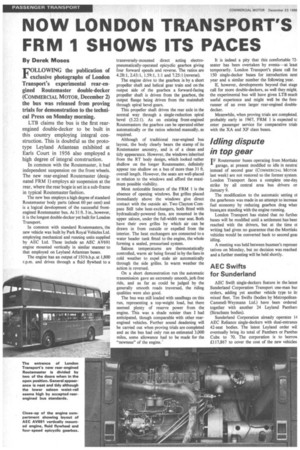NOW LONDON TRANSPORT'S FRM I SHOWS ITS PACES
Page 14

If you've noticed an error in this article please click here to report it so we can fix it.
By Derek Moses
FOLLOWING the publication of exclusive photographs of London Transport's experimental rear-engined Routemaster double-decker (COMMERCIAL MOTOR, December 2) the bus was released from proving trials for demonstration to the techni
cal Press on Monday morning.
LTB claims the bus is the first rearengined double-decker to be built in this country employing integral construction. This is doubtful as the prototype Leyland Atlantean exhibited at Earls Court in 1956 also employed a high degree of integral construction.
In common with the Routemaster, it had independent suspension on the front wheels. The new rear-engined Routemaster (designated FRM 1) employs air suspension at the rear, where the rear bogie is set in a sub-frame in typical Routemaster fashion.
The new bus employs a high degree of standard Routemaster body parts (about 60 per cent) and is a logical development of the successful fronteng1ned Routemaster bus. At 31 ft. 3 in., however, it is the longest double-decker yet built for London Transport.
In common with standard Routernasters, the new vehicle was built by Park Roy at Vehicles Ltd. employing mechanical and running units supplied by AEC Ltd. These include an AEC AV691 engine mounted vertically in similar manner to that employed on Leyland Atlantean buses.
The engine has an output of 150 b.h.p. at 1,800 r.p.m. and drives through a fluid flywheel to a transversely-mounted direct acting electropneumatically-operated epicyclic gearbox giving four forward speeds and reverse. The ratios are 4.28:1, 2.43:1, 1,59:1, lf 1 and 7.25:1 (reverse).
The engine drive to the gearbox is by a short propeller shaft and helical gear train and on the output side of the gearbox a forward-facing propeller shaft is driven from the gearbox, the output flange being driven from the mainshaft through spiral bevel gears.
This propeller shaft drives the rear axle in the normal way through a single-reduction spiral bevel (5.22:1). As on existing front-engined Routemasters the gearbox can be operated either automatically or the ratios selected manually, as required.
Although of traditional rear-engined bus layout, the body clearly bears the stamp of its Routemaster ancestry, and is of a clean and tidy appearance. However, the windows inherited from the RT body design, which looked rather shallow on the longer Routemaster, definitely appear too shallow on a bus of more than 31 ft. overall length. However, the seats are well-placed in relation to the windows and afford the maximum possible visibility.
Most noticeable feature of the FRM 1 is the absence of opening windows. But grilles placed immediately above the windows give direct contact with the outside air. Two Clayton Compass Still tube heat-exchangers, both fitted with hydraulically-powered fans, are mounted in the upper saloon, under the full-width rear seat Both have their own grilles by which air can be drawn in from outside or expelled from the interior. The heat exchangers are connected to a water header tank fitted to the engine, the whole forming a sealed, pressurised system.
Saloon temperatures are thermostatically controlled, warm air being forced in by the fans in cold weather to expel stale air automatically through the side grilles. In warm weather the action is reversed.
On a short demonstration run the automatic transmission gave an extremely smooth, jerk-free ride, and as far as could be judged by the generally smooth roads traversed, the riding qualities were also good.
The bus was still loaded with sandbags on this run, representing a top-weight load, but there seemed plenty of reserve power from the engine. This was a shade noisier than I had anticipated, though comparable with other rearengined vehicles. Further sound deadening will be carried out when proving trials are completed and as the bus had only run an estimated 3,000 miles, some allowance had to be made for the "newness" of the engine. It is indeed a pity that this comfortable 72 seater has been overtaken by events at least temporarily. London Transport's plans call for 150 single-decker buses for introduction next year and a similar number the following year.
If, however, developments beyond that stage call for more double-deckers, as well they might, the experimental bus will have given LTB much useful experience and might well be the forerunner of an even larger rear-engined doubledecker.
Meanwhile, when proving trials are completed, probably early in 1967. FRM 1 is expected tc enter passenger service for comparative trials with the XA and XF class buses.












































































